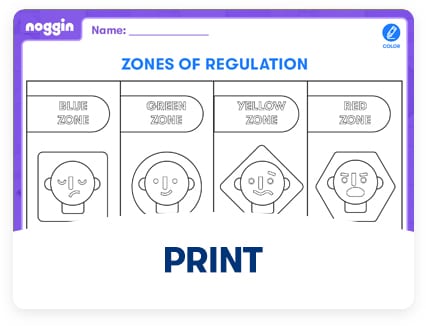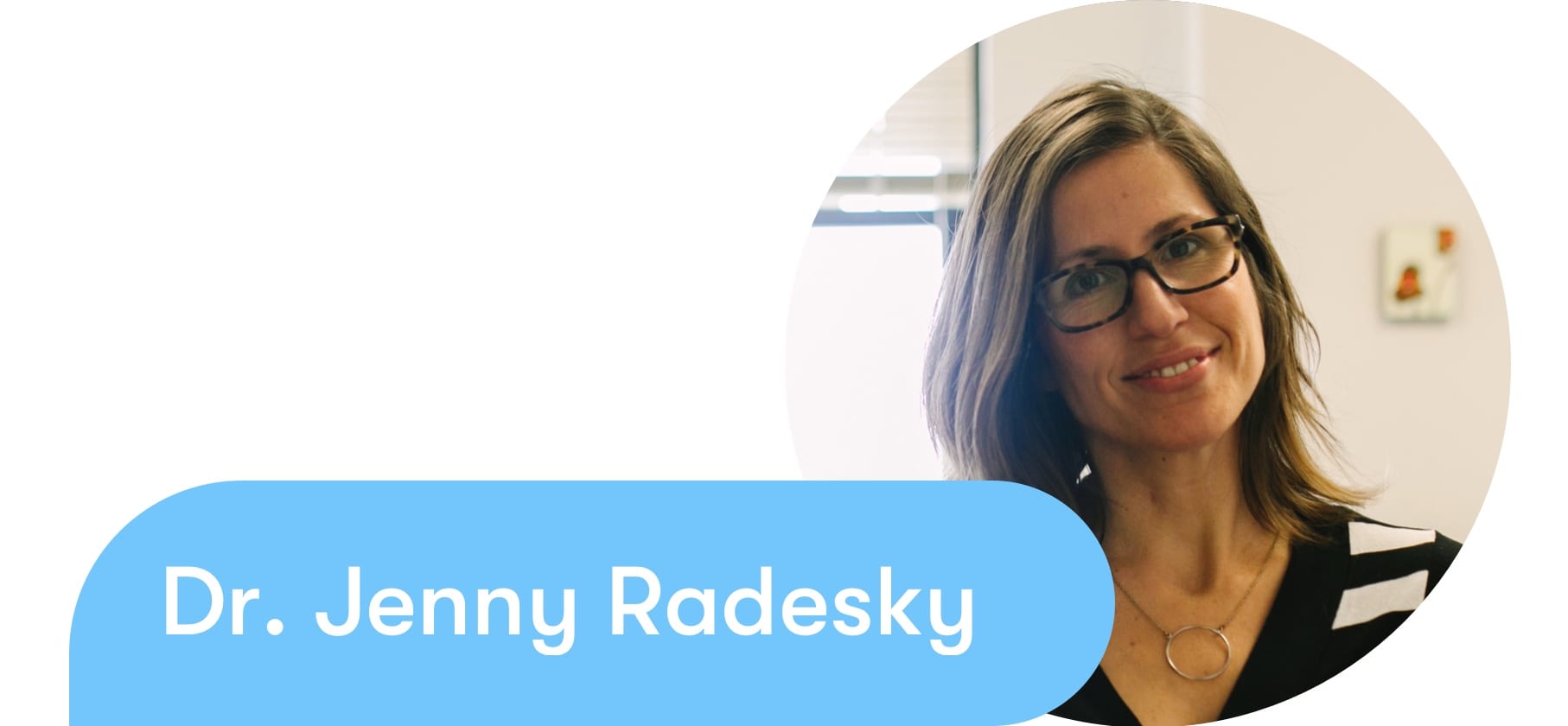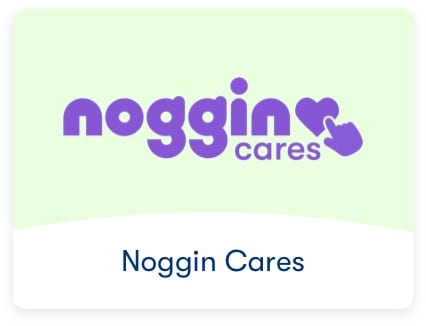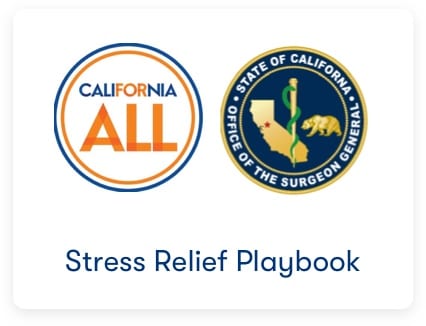💡Skill: When you identify how you are feeling and talk about it, you are showing your ability to regulate your emotions.
Feeling Faces with RubblePosted by NOGGIN on Tuesday, March 17, 2020
Description
We all feel a lot of different emotions. Let Rubble help kids explore emotions and expressions, and then let’s work together to see what color emotion we’re feeling today!
Extend the Learning
Let’s use this printable to figure out what color emotion we’re feeling right now. Let’s try drawing a picture with that color. Let’s think about other times when we’ve felt the other colors/emotions?
Words to Use
- Emotion – a feeling
- Feeling – how your mind and body react to something

What basic information can you give to a child about this crisis?
Dr. Nadine Burke Harris: One of the things that’s really helpful for little ones, because they don’t have a sense of how long this is going to go on for, is to really focus on being honest.
And then another thing that’s really helpful is to focus on the time period that makes sense for a five-year-old.
What can we do today? What can we do tomorrow?
We can focus on activities that can keep them engaged and understanding of what’s happening right now.
Is it OK for me to say “I don’t know right now?”
Dr. Nadine Burke Harris: That’s absolutely OK to say “I don’t know.”
I think that one of things that we’re learning is that it’s an opportunity to teach our kids.
What do we do when times are difficult and we’re not sure what’s going on?
How do you explain social distancing to a child?
Dr. Nadine Burke Harris: So for my little ones – my seven-year-old and my four-year-old, one of the things we talk about when we say “remember social distancing!” is that we try to make a game of figuring out how far six feet is.
How far is six feet? Is it as long as that hammock? Is it from here to the stop sign?
And that helps us to be able to play. Still practice social distancing but doing it in a way that it’s not this very awful thing it’s more this game that we can all interact with.
What’s the best way to address big-picture issues like why kids can’t go to the grocery store, to someone who has a smaller capacity to understand them?
Dr. Jenny Radesky: Explaining rules in really simple language, in ways that just say “Right now Mommy needs to do this by myself. But we can play grocery store later.”
If you think of the reasons why she loves that experience with you and maybe try to recreate some of those later on in your day, it may help her cope with the new limit that’s placed.
Is it OK to cry in front of your kids?
Dr. Nadine Burke Harris: This gives us a chance to model for our kids what it’s like when we’re feeling really sad. When we’re feeling really overwhelmed.
And you know what? Sometimes that means that we’re going to cry. But the really important thing is how we come back together.
Letting go of the notion that as parents we always have to have it 100% together. 100% of the time.
It speaks to the issue that self care isn’t selfish. Our well being as parents is really important and it impacts the way that we parent, the way that we respond when our kids have questions.
Is it OK for kids to see their parents snapping or feeling frustrated?
Dr. Jenny Radesky: It just shows that you’re thinking so hard about what your kids need right now. And when you’re thinking hard about what your kids need during a stressful time, you’re doing awesome.
So don’t worry about it, don’t be hard on yourself.
The act of messing up actually lets you repair with your kids, and actually say “Oh, I’m sorry I yelled at you! I was just feeling so full of tension because of X Y and Z.”
How can we help kids process emotions that maybe they don’t fully understand?
Dr. Jenny Radesky: Emotions are complicated for grown ups to understand too.
And you can have many of them at one time. I actually find that kids understand emotions better in terms of colors and pictures. So I use a curriculum called “Zones of Regulation”, it has all these nice visuals that I draw out. Where if you’re in the blue zone you’re feeling kind of bored and cranky or just sad. When you’re in the green zone you’re calm and relaxed and focused. When you’re in the yellow zone kind of silly or amped up or agitated. And then red zone is out of control.
And the other nice thing about this is that we can say, “You’re in the yellow zone, how can you get back down to green?”
That’s one approach you can take with a young kid where those colors kind of really resonate with them as a way of thinking through what’s a really abstract concept.
Do you have any advice on helping families combat stress during this time?
Dr. Nadine Burke Harris: It’s really important for parents and kids to understand that when we’re feeling more stress that it isn’t just all in our heads.
That during this time our bodies may actually be making more stress hormones.
But there are simple things that we can do everyday at home to help to regulate the amount of stress hormones that our bodies make.
Regular exercise – everyday, even if it’s just an indoor dance party.
Sleep – having those regular hours of going to bed and waking up at the same time, keeping to that routine is really important.
Mindfulness – that really helps to regulate us and kind of calm our nervous system down.
Nutrition
Social support – having those safe and stable relationships are really important.
And for those who are finding themselves really struggling, now’s a great time to reach out to get mental health support.
A lot of parents are also worried about what to do if their kids get sick during this time, not with COVID, and so should they go to the doctor or is that risky right now?
Dr. Jenny Radesky: It’s understandable that parents feel nervous about going to the doctor.
If you’re unsure and you’re feeling worried about bringing your child in for a checkup or vaccination or an injury, it’s really important to reach out to your child’s pediatric provider.
And just ask – say, you know “I’m feeling nervous about COVID, what are you doing to keep things clean, to keep kids separated?”
How do you manage getting the workload done and giving individual attention to each of the kids?
Dr. Nadine Burke Harris: If it feels like a lot, it’s because it is a lot, so I want to acknowledge that.
A lot of us who have our checking boxes and our lists and all of that kind of stuff, we may not get as much done as we would hope to.
So just start by giving yourself a break.
You can tell your spouse or your partner or whatever or yourself, you know the Surgeon General of California says it’s OK to give yourself a break.
Dr. Jenny Radesky: If you don’t, you run the risk of burning out.
This is gonna be months and months, we’re not really sure when it’s gonna let up.
And if we try to over do everything and check off all those usual boxes that we would when life is normal, then you might actually risk making yourself overly anxious.
Lower your expectations of yourself and of your kids, and just focus on the few things you think that really matter.
Dr. Nadine Burke Harris: One of things that I have heard of, is some parents actually take shifts. It’s simply not possible to be a full time employee and a full time educator and a full time parent all at the same time.
Dr. Jenny Radesky:I was just going to add that it’s really OK to ask teachers if there’s some flexibility around the tasks that have been assigned.
And also to just make some decisions, some executive decisions on your own about what’s gonna work for your family.
Dr. Jenny Radesky: And also remember that we’re not all trained as teachers and educators. And it’s not actually normal for us to be around our kids all day.
They need independence from us, and we need independence from them, so it’s OK to be a little creative about what we set up our day as.
The first week when we had no idea what we were doing, my husband did paper planes with my six and ten year old and they just fixed around with it for a couple of hours and we called it science class.
So you can be a teacher in those ways and those life skills matter just as much as the sight words or math facts that your child is maybe missing out on right now.
How will this impact kids socially since kids are not in school, socializing with kids their age?
Dr. Jenny Radesky: I think the way that we set kids up for success to do that is to really try and work on their flexibility.
When you’re playing with them you can work on turn taking, flexibility, seeing things from someone else’s perspective, working together on something, following commands, following steps and finishing something out, not losing your attention span.
All those things will help kids with the re-entry process.
And kids are resilient, they will bounce back from a lot of this.
So I don’t want people worrying about long term damage.
Should I feel guilty about the amount of screen time I’m giving my child?
Dr. Jenny Radesky: I want parents to know that we’re all gonna have a lot of more times on screens during this pandemic.
And it’s because we need them.
I don’t even like the word “screen time” because it only talks about duration, we’re not talking about the other things that matter.
One way to think about this is promoting the Three C’s.
The first C is who is your child?
Are they the sort of child who becomes obsessed with certain media and needs a lot of rules? Or are they pretty easygoing?
The second C is content.
Violent content really just riles them up and makes it hard for them to sleep. It’s a good idea to choose something positive like Blue’s Clues and You.
Three is context.
So you are one of the parts of your context, you know, how are you watching or talking to your child about what you’re seeing?
Another part of context is what emotions were you feeling right before you started using media.
I hope that reduces the guilt, guilt we often feel when we feel powerless or we feel like we aren’t meeting up to some expectations. There is no expectation right now because this is so different then what we’ve ever experienced before.
So if there’s one thing I would say for parents is to just let go of the guilt.
If you could have a moment especially for your own self care. It’s OK to relax a little on the screen time so that you can have that time.
How do you keep your kids happy, engaged and learning when they’re not able to leave the house?
Dr. Kathy Hirsh-Pasek: One thing to keep in mind is that play and learning aren’t separate.
First of all, believe it or not, one of the things that helps kids learn math is being able to recognize a pattern.
So to follow a pattern when you do a hand clapping game or a simple board game, has the kids roll a dice, ah yes they have to add.
And a simple game of Simon Says, teaching self control.
Noggin asked the Surgeon General of California and other leading experts how to handle the stress of the pandemic on little kids. With help from Jamie-Lynn Sigler, a mom and superstar host, and parents just like you, this 20-minute special will help answer questions you have about your kid’s health and learning during this challenging time.
View All Parent Questions Here
Meet The Speakers
Actress Jamie-Lynn Sigler (The Sopranos and Entourage) is a superstar mom of a two-year-old and six-year-old and the host of “Mama Says,” “Pajama Pants,” and “Are You Smart Enough to Home School.” Through her podcast, “Mama Says,” Jamie-Lynn helps bring comfort and laughter to listeners by sharing parenting truths, tricks, and of course, embarrassing mommy moments — making her the perfect host for “Navigating the New Normal: Parents Edition.”
Dr. Nadine Burke Harris is California’s first Surgeon General, and in that role, she serves as the leading spokesperson on the most pressing public health challenges. Her background includes years of public service as an award-winning physician and researcher. She’s a tireless advocate for combating health disparities and transforming the way society responds to children exposed to Adverse Childhood Experiences (ACEs) and toxic stress. As the lead expert for “Navigating the New Normal: Parents Edition,” Dr. Nadine Burke Harris breaks down the science of stress and provides simple strategies to help parents support their children through a crisis. With compassion and deep expertise, she tackles misconceptions and answers questions from families.
Dr. Jenny Radesky is a Developmental Behavioral Pediatrician, an Assistant Professor of Pediatrics at the University of Michigan Medical School, and author of the 2016 American Academy of Pediatrics digital media guidelines for young children.
A leading expert in children’s media engagement and special guest on “Navigating the New Normal: Parents Edition,” Dr. Radesky explains the importance of understanding the Three C’s when it comes to kids on devices: the Child, the Context, and the Content. Her balanced and practical perspective helps parents deal with the reality of more “screen time” during this extraordinary time.
Dr. Kathy Hirsh-Pasek is a Psychology Professor at Temple University, and Senior Fellow at the Brookings Institution. Her research includes examining the impact play has on learning.
As a special guest on “Navigating the New Normal: Parents Edition,” Kathy Hirsh-Pasek explains that play and learning are deeply connected. She shares how simple games parents can play with their kids today are actually teaching important skills like math and self-control.
Resources
Try Noggin Today: Subscribe
💡Skill: When you think about people and things you are grateful for, you show empathy.
What Are You Grateful For?Posted by NOGGIN on Tuesday, March 17, 2020
Description
We are all grateful for special people and things in our lives. Guess which Noggin friend is grateful for what- who is grateful for stinky socks? A bubble puppy?
Extend the Learning
Help your little ones create their own grateful jar or use our gratefulness printable to get started!
Words to Use
- Grateful – to be thankful for something
- Special – something very important to you









💡Skill: When you breathe in and out, you calm your body and focus your brain.
Count it Out!Posted by NOGGIN on Tuesday, March 17, 2020
Description
We all get frustrated sometimes. Watch Peppa Pig and learn how to calm our bodies and clear our minds.
Extend the Learning
Sing along to Peppa Pig’s “Count it Out” and memorize the song so you can use it throughout the day if a frustrating moment may arise.
Words to Use
- Frustrated – sad and upset
- Memorize – to remember without having to look









💡Skill: Pretending to be different jungle animals builds your big muscles and builds your creativity!
Description
Take a trip to the jungle and breathe as you go!
Extend the Learning
Continue your “imagination trip” by taking turns closing your eyes and breathing. Open your eyes and act like a jungle animal; I will guess what you are! Let’s do it again!
Words to Use
- Imagination – a picture in your mind
- Jungle – a place with lots of trees and plants and animals
- Trip – a visit to another place









💡Skill: Yoga poses build concentration and balance.
Yoga Friends: Genie Warrior Pose with ShinePosted by NOGGIN on Monday, May 4, 2020
Description
Learn a power pose and reclaim your strength. You can do this!
Extend the Learning
Warriors are silent and strong! Challenge everyone in the family to say “shhh!” and join Shine to hold the warrior pose. Who can hold the warrior pose the longest and stay the quietest?
Words to Use
- Pose – to put your body in a certain position
- Warrior – someone who is brave and strong









Extend the Learning: Animal Guessing Game
Get up and groove! It’s time to learn some new dance moves from Chickaletta! Flap your wings, cluck, and try not to lose any feathers! Catch more of Chickaletta and the whole PAW Patrol team in the Noggin app!









Extend the Learning: Save the Animals
Take a trip to the African mountains with Diego and meet some awesome gorillas! Once there, kids can practice sign language with Diego’s friend and the amazing animals.
Learn more about wildlife with an animal expert by watching more “Go, Diego, Go!” in the Noggin app.









Extend the Learning: Virtual Field Trip to the San Diego Zoo
Play "Zoomed in Zoo" with Molly!Posted by NOGGIN on Sunday, April 26, 2020
Molly’s going to zoom in on an animal at the zoo, and your family can try to guess what kind of animal it is! Take a look at Molly’s feathery friend, and listen closely to Molly’s hint. Can you guess the animal? Play more with Molly in the Noggin app.


























